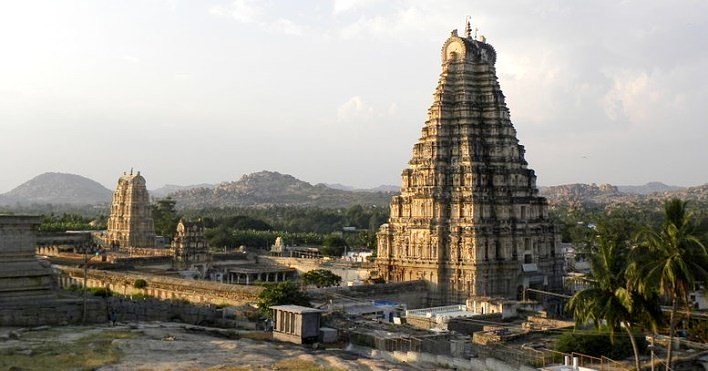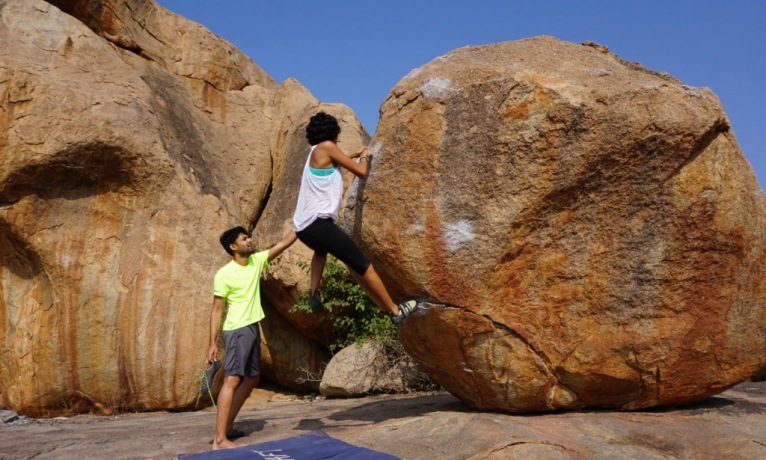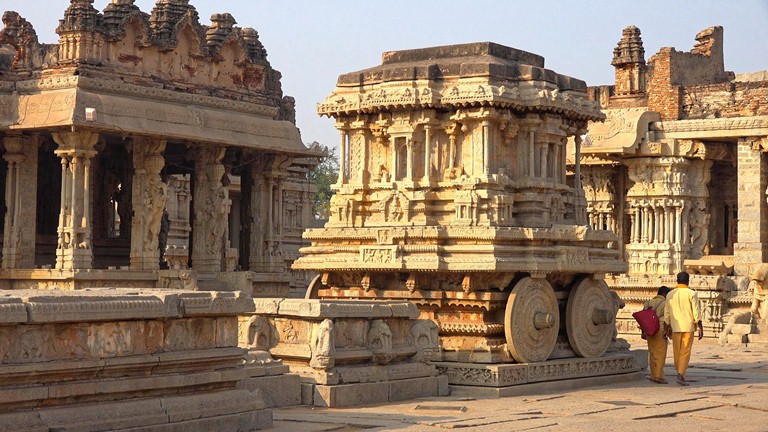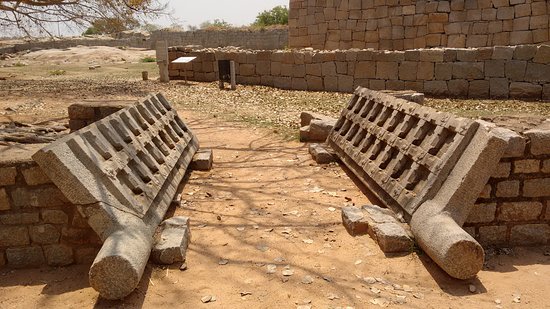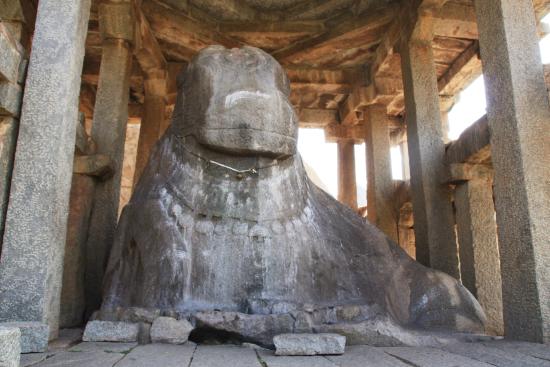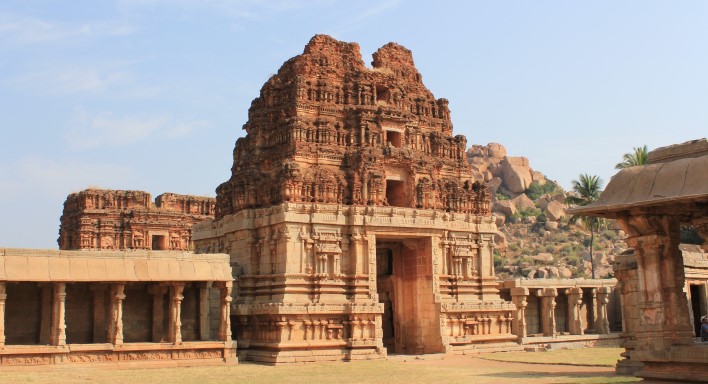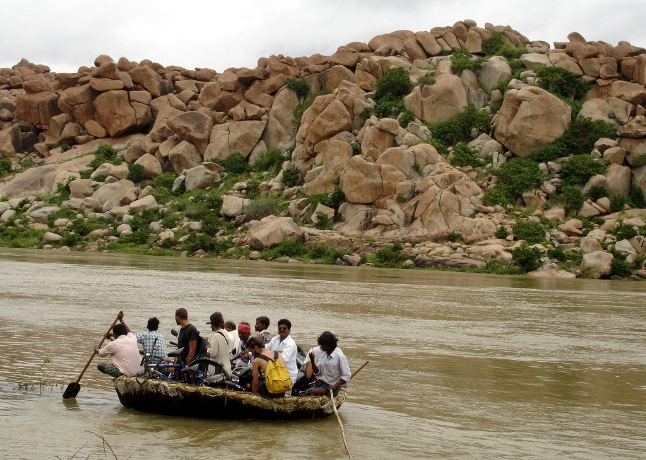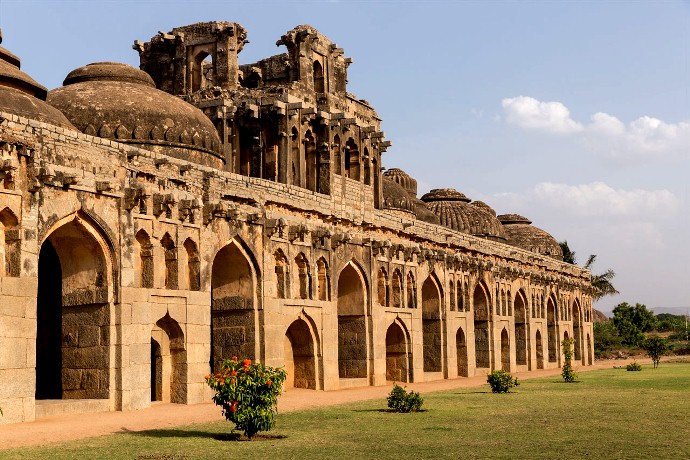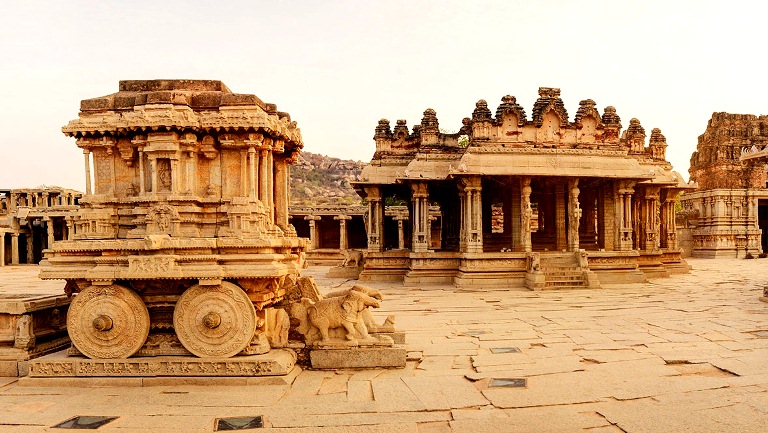
The Hampi Group of Monuments is a UNESCO World Heritage Site which still looks glorious enough to be the capital of a powerful empire. Its popularity has grown rapidly over the centuries. Its a little rugged-canvas festooned with historical structures that reflect ancient charm, grandiose and precision. These iconic remnants of Vijaynagara Empire have its history dating back to 14th century. Every bend on the road here is decorated with a temple, while on every hillock sits a canopy like monument, attracting passersby.
Hampi Stone Chariot has served as the inspiration for various ideas and events, one of them being India award-winning luxury trains, The Golden Chariot. Here, you come across wonderful structures like the Virupaksha Temple, which celebrates the wedding ceremony of Lord Shiva and Goddess Parvati every year. The long stretch of bazaars here give a feeling of waiting in expectation for the commerce and trade to resume, as it did once upon a time.
Wonders like the Vijaya Vittala temple leave the visitors awestruck here. In the evenings, when the sun rays bathe the temple, it appears to be made of gold. The Royal Enclosure, the massive elephant stables, the Lotus Mahal, the Hazararama Palace and the Victory Platform, the wonders never seem to cease. The detailed carvings and ample display of creativity in architecture shed light on the excellent heights of craftsmanship achieved by the artisans. Is it any wonder then today, that the Hampi Group of Monuments is a UNESCO World Heritage Site and the most googled historical place of Karnataka?
Inscribed by UNESCO as World Heritage Site, the Group of Monuments at Hampi are at once forlorn yet majestic. The sprawling structures which once were part of mighty Vijaynagara Empire now lay in ruins in a magical landscape shaped by millennia of volcanic activity.
The landscape dotted with big boulders, rock formations and hills is dotted with random patches of paddy fields or banana plantations. The overall view is surreal and strikingly unforeseen. Lying on the banks of the Tungabadra River, Hampi with its legends and narratives of grandeur and tragic collapse of a mighty empire is one of the top tourist destinations in India especially for connoisseurs of heritage and culture.
The top attractions in Hampi are a series of enclosures, baths, temples and palaces, most of which are in ruins these days. Sightseeing here also involves visiting the underground temples, corralling on the placid water of Tungabadra River and visiting the Archaeological Museum.
Apart from the above, glimpses of brilliance can be viewed in the majestic Lakshmi Narasimha, the Stone Chariot, the enormous Ganesha statues and the Badavilinga. Plan your trip to Hampi with our list of top things to do in Hampi.
Virupaksha Temple- Virupaksha is one of the top tourist attractions in Hampi located beside the southern bank of Tungabhadra River. The temple is dedicated to Lord Shiva and is also known as Shri Lokeswara Maha Sila Prasada. According to mythology, it dates back to 7th Century AD, and this makes it one amongst the oldest temples in India. Lokamahadevi, the queen of Vikramaditya, built this temple to commemorate her husband triumph over the Pallavas of Kanchipuram. Since its inception, the complex gradually grew; lamp posts, flag posts, pillars, pillared halls, sub-shrines, towered-gateways, temple kitchen etc were added with the growing time. UNESCO has considered this temple as a World Heritage Site, as a part of Hampi Group of Monuments. Kailasanatha Temple in Kanchipuram looks somewhat similar to Virupaksha Temple on the basis of plan and elevation.
Rock Climbing in Hampi- One of the UNESCO Heritage Sites in India, Hampi is a destination known for holding great historical significance. Hampi is well known as a paradise for rock climbers as it has much to offer to every rock climbing enthusiast. People from all over the world visit the place to experience the various opportunities in bouldering.
Hampi has carved a special place as a rock climbing destination. With its rocky landscape and ancient temple ruins, Hampi promises a lifetime opportunity to every rock climber. Hampi is visited by a number of rock climbing enthusiasts from different parts of the world. It is a must visit destination for all those who wish to test their rock climbing abilities. In Hampi, one gets to enjoy rock climbing amidst nature.
Vittala Temple Complex- Revealing the art and architecture of Vijayanagara Empire, Vittala Temple Complex is one of the major tourist attractions in Hampi. The complex and its structures embody the pinnacle of Dravidian temple architectural style. The name of the temple Vittala itself defines the history behind; Vittala, a form of Lord Vishnu who was worshipped as a prime deity by the local herdsmen of the empire.
Vijay Vittala or simply Vittala Temple is the most famous and popular tourist attraction in Hampi. It was build around 15th Century AD and was expanded several times by succeeding kings of the empire. The temple is constructed in the form of a large complex with compound walls and gateway towers. The entire complex houses several temples, enclosures, pavilions and halls.
Stone Doors- Every stone tells a story in Hampi, so goes a popular saying. It is believed that it was here amidst the now standing ruins of Hampi and its stone structures, Dravidian architecture reached its Zenith along with the Vijayanagara Empire. One such structure which stands testimony to the golden reign of Vijayanagara Empire is the Stone Doors.
Stone doors are located in the northwest direction of Royal Enclosure and supposedly formed the entrance of the Royal Enclosure area of the Queen Bath. As per the popular beliefs, stone doors were used in the entranceway of a regal building.
These grey ruins are a replica of carved wooden doors, but are made of stones. It has been decorated by carving in protruding lotus buds in the junctions. These doors have bots and pivot shafts at the end and it is believed that elephants were required to open these massive and heavy doors.
Monolithic Bull- Placed like a guard, the Monolithic bull in Hampi is a grand piece of architecture. The impressive and huge structure of the Monolithic bull is locally named as Yeduru Basavanna or Nandi. As per Hindu mythology, Nandi is the vehicle of Lord Shiva. Contradictory to its rough texture, the gigantic statue of Nandi attracts a lot of visitors. The statue of the Monolithic bull is placed just opposite to the Virupaksha temple in Hampi.
In the Hindu mythology, sage Shilada wanted an immortal child and no other than Lord Shiva could grant him that wish. Over this, Lord Indra advised him to worship the almighty Shiva. Shilada started worshipping Shiva for centuries, impressed by this, the Lord granted him his wish of an immortal child. The immortal creature was Nandi, the bull created out of Shiva mere bones. With such a sacred status, Nandi became the vehicle of Lord Shiva and people started worshipping it.
The sacred statue of the Monolithic bull was built on a two storied pavilion constructed and raised on a platform. With a picturesque pavilion, the bull looks quite fascinating. Although a bit mutilated, the gigantic structure of Nandi still manages to catch the eyes of the passersby.
Achyuta Raya Temple- Built in the year 1534 AD, the mesmerizing Achyutaraya temple is an ideal example of Vijaynagara architecture style at its very best. One of the top attractions in Hampi, the temple is situated between the Gandhamadana and Matanga hills in the Hampi region of Karnataka. Dedicated to Lord Thiruvengalanatha or Venkateshwara, this glorious temple at Hampi was built by Vijaynagara ruler Achyuta Deva Raya. Owing to the architectural finesse, this temple is one of the most popular tourist places to visit in Hampi.
The Achyutaraya temple has two Gopura marked enclosures. Once inside the complex, one is likely to find the main temple within the second enclosure. A shrine of Garuda, which is a celestial bird and also known as carrier of Lord Vishnu, is kept just opposite to the temple. Other than the Garuda statue, the complex also houses one more shrine which is at the southwest of the temple.
It is believed that the construction of Achyutaraya temple complex involved setting up of a Kalyan Mandapa. Being associated with the annual marriage ceremony of the deity, the construction of Kalyan Mandapa was a common practice and can be seen in various other temple complexes of that time. The Kalyan Mandapa in the Achyutaraya temple has been aesthetically carved.
Coracle Crossings- Call it a floating basket or a boat, the Coracle is a huge traditionally designed craft used to ferry people across the river. These baskets are woven of cane from the inside, whereas the leather on the outside with a fine coating of plastic sheets and bitumen make it a leak proof floating material. Being brought into use by the locals of Hampi since five centuries back, the modern day Coracle looks exactly the same as the old one except a slight change in the list of manufacturing materials. With the addition of plastic and bitumen sheets in its design, these circular floating boats can even ferry horses and other live stocks.
One is likely to get the sight of the coracles in abundance while exploring the streams of Hampi and the rocky terrain on their banks.
The prominent Coracle crossings in the Hampi region are branched into three. The first coracle crossing is confined to the Ghats (bathing region) near the Virupaksha temple. Tourists hop on to their coracles and cross the river. Well, it's not simply just crossing the river through a boat. The ride of the coracle feels a bit different, more like river rafting as the streams tend to get quite rough at times.
Lakshmi Narasimha Temple- Lakshmi Narasimha Temple is situated in Hampi, a small village in northern Karnataka. The temple has the biggest statue of Narsimha, identified by its different names Ugra Narasimaha and Unganarsimha. Narasimha is well -recognized to be one of the ten avatars of Lord Vishnu. The statue comprises of Narsimha sitting on seven headed enormous snake curved all around and the head of snake acts like a cover on top of the Narasimha head. The original statue which was destroyed during several raids on Vijayanagara Empire, was that of Goddess Laxmi, the wife of God, sitting on his lap. Even the shattered part of the statue is missing. At present just the hand of Goddess Laxmi attached to Narsimha back is noticeable clearly. Therefore, the existence of both the god and goddess defines the name of the temple Lakshmi Narsimha. The timings to visit the temple is from 6am - 6pm, on all days and the visit duration is generally 1-2 hours.
Elephant Stables- As the name says, this least dilapidated structure and one of the major tourist attractions in Hampi today was once the stable for elephants which where used by royalty. In total there are 11 domed chambers, tall and inter-connected, giving it a grand appearance. These halls have different shapes, such as drum-shape and octagonal. In the middle is an ornate hall that was perhaps used for ceremonial gatherings that included elephant processions. Its towers look similar to those of the temples of that era. Elephant Stables are symmetrical with respect to Central Hall. Each hall has opening for Mahouts to enter the compartments and metal hooks to tie the elephants. The stables are also a gateway to Guard Quarter and Ranga Temple, some of the other popular attractions in Hampi.
Need Aspark Help?
For Tour Packages, Vehicle Rental and Customer Care Support.
+91 9999 31 7846
booking@asparkholidays.comWhy Travel with Us?

Excellent Support
Our Team Available 24x7 for Customer support
Best Price & Savings
We Offer the Most Competitive Prices.
